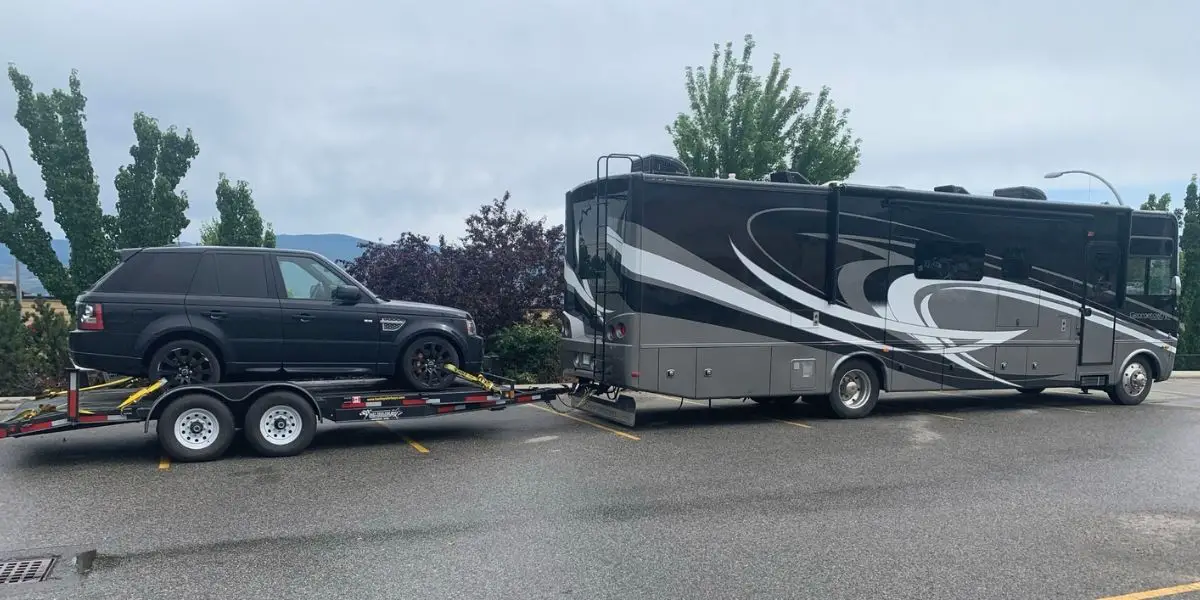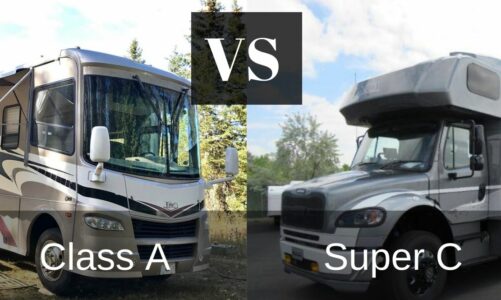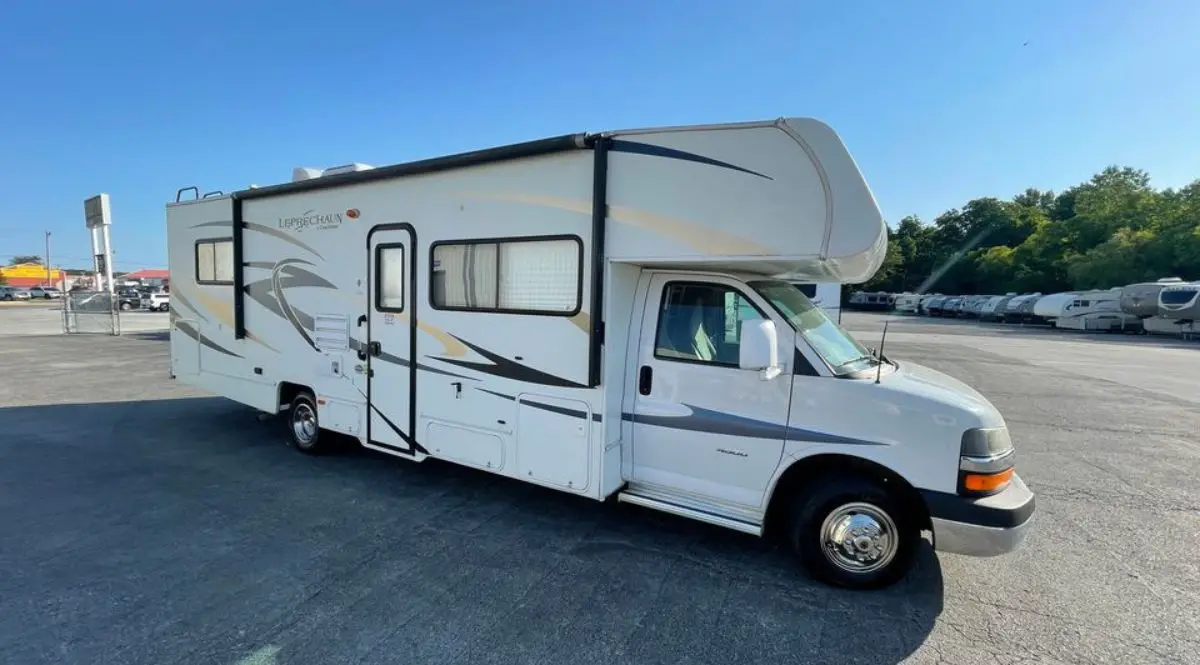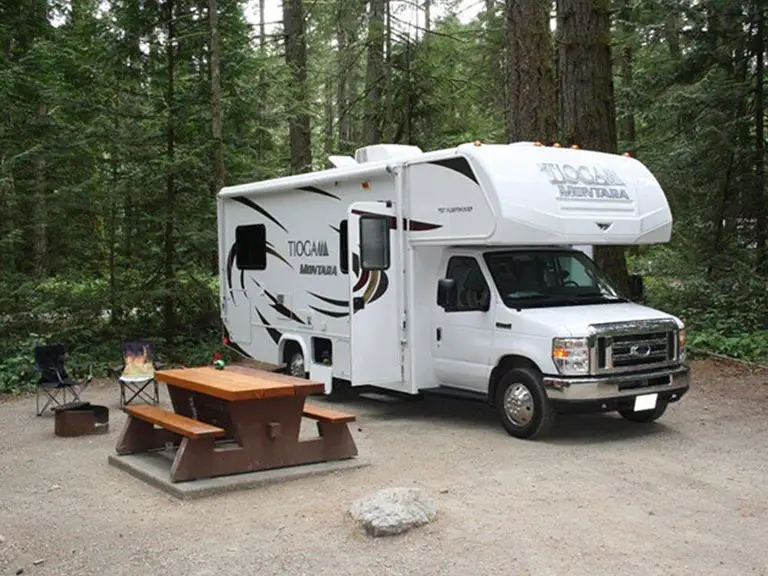Curious about how much a motorhome can tow? The amount a motorhome can tow will highly depend on the RV type, (A, B, C or Super C) and age, it can range between 3,500 – 40,000 lbs (1,587 – 18,143 kg). Each make and model will have its own unique build to be able to tow maybe more or less than the other motorhomes in the same class.
Typically, a Class B will tow less at 3,500 to 5,000 lbs; a class C can tow from 5,000 lbs to 8,000; A Class A will tow 10,000 to 15,000 lbs and a Super C will tow 10,000 to 40,000 lbs.
If you have a Class B or Class C and you want read more on what it can tow, you can read more about it here or if you want to read more about super C’s. To determine your own towing capacity of your motorhome there are a few numbers that are required to know to calculate your own numbers.
How Do You Determine The Towing Capacity Your Motorhome?
To determine the towing capacity of your motorhome, you’ll first need the following numbers:
1. Maximum Towing Capacity – found under the chassis or getting the difference between the Gross Combined Weight Rating (GCWR) and the Gross Vehicle Weight Rating (GVWR).
2. Gross Vehicle Weight Rating (GVWR) – found inside the driver’s door, under the tire pressure plate. This is the maximum weight the motorhome is allowed to have, fully loaded with fuel, water, people and cargo (includes the tongue weight, but not the towed vehicle).
3. Gross Combined Weight Rating (GCWR) – found under your chassis ‘specifications’ which will be the GVWR + the tow car/trailer/boat, etc.
4. Gross Axle Weight Rating – Total weight on each vehicle axle
5. Gross Trailer Weight – Total weight of the trailer
6. Tongue Weight – Total weight at the coupling point. Can be computed after getting the weight of the loaded tow vehicle (e.g. your motorhome) and the weight of the tow vehicle and the attached trailer.
7. Hitch Rating – found on the RV hitch where the ‘hitch weight rating plate’ will indicate how much you can tow. If the number indicated here is lower than the Maximum Towing Capacity, then you have to follow the hitch rating.
8. Occupant and Cargo Carrying Capacity (OCCC) – Also called the ‘payload’ and it’s found on a sticker found only on motorized RVs (the location of the sticker depends on the manufacturer, some are found on the inside of the driver’s door). OCCC is the maximum allowable weight of all occupants/passengers and cargo (gas tanks, personal belongings, food, etc.).
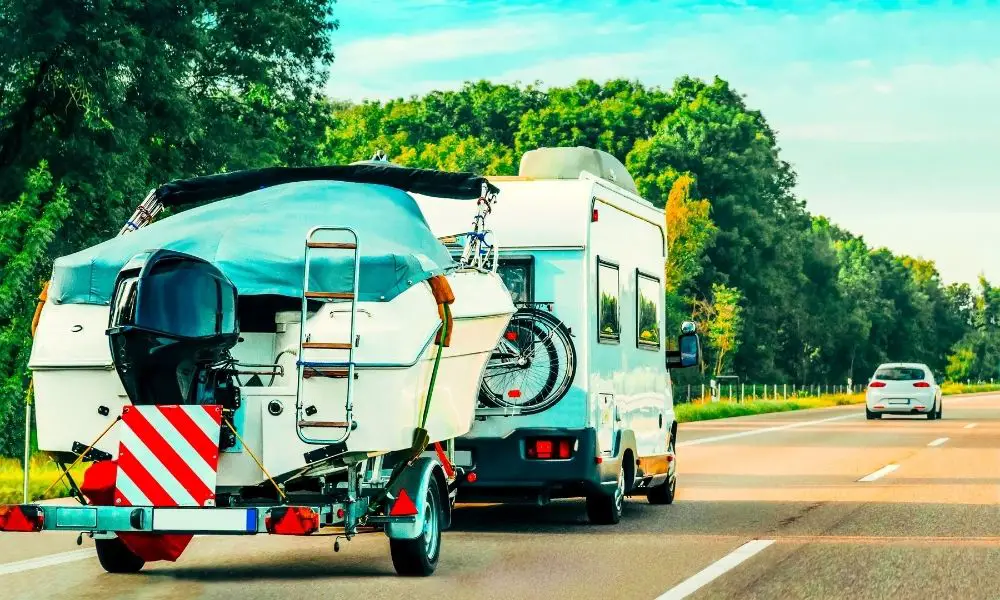
Keep in mind that the size of the engine and the weight of the motorhome (without any load – passengers, cargo, fuel, etc.) determines your RV’s capability to tow. Let’s say you want to compute for the weight of your unladen RV, you can use this formula:
GVWR – OCC = Empty RV
So when you do want to compute for the GCWR, you basically just need to add:
Loaded RV + Towed vehicle weight = Total Weight (Should be < than GCWR)
In case you’re not sure how much your loaded RV is, make sure you also add:
1. Empty RV weight
2. Driver weight
3. Passenger(s)/pet(s) weight
4. Water weight (check the OCCC sticker; should include water in the water heater, and if ever full grey &/or black tanks)
5. Full propane tank weight
6. Food
7. Cargo
Can A Motorhome Pull A Trailer?
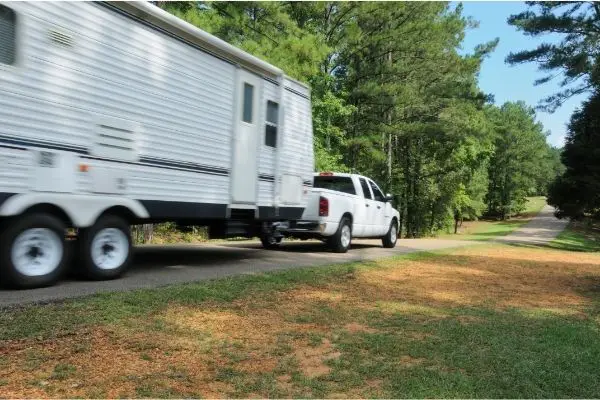
Towing a trailer behind a motorhome is a great idea to add more space for sleeping or towing more toys. A motorhome can certainly pull a trailer depending on the weight of the trailer and the towing capacity the motorhome. It comes down to the calculations of weight of the trailer and the towing capacity of the motorhome.
The table below is a quick guide when it comes to the weight the motorhome can pull (and also the weight of the trailer). Though your personal situation will be a little different than what is listed here. Remember to check the weight & length legal limitations stated in your country/federal/state/local laws (see next section).
|
Motorhome Classes |
Motorhome Weight (lbs) |
Can Tow (lbs) | Be Wary Of |
Things Usually Towed |
|---|---|---|---|---|
|
Class A* |
13,000-30,000 |
10,000-15,000 |
Length Restrictions |
Tow-behind car |
|
Class B |
6,000-8,000 |
< 5,000 |
Weight Restrictions |
Small/lightweight boats, ATVs motorcycles, snowmobiles, light campers |
|
Class C** |
10,000-12,000 |
5,000-10,000 |
Length & Weight restrictions |
Some can pull boats, trailers or longer items (keeping within legal length restrictions) |
|
Super Class C |
10,000-50,000 |
Up to 40,000 |
Length & Weight restrictions |
Pull boats & trailers at the same time (keeping within legal length restrictions) |
*Heavier types with smaller engines won’t be able to pull much
**Small Class C may not be able to pull much; Usually shorter than Class A types, some are on heavy-duty truck chassis
Table below shows the average weights and GVWR for the different types of trailers (and should only serve as a guide—please check the actual Owner’s Manual):
|
Travel Trailer Classes |
Trailer Type |
Average Empty Weight (lbs) |
GVWR (lbs) |
|---|---|---|---|
|
Campers |
Pop-up Camper Teardrop Trailer A-Frame Camper Small Travel Trailer Large Travel Trailer Fifth Wheel Camper |
2300 1700 1700 2800 6700 12700 |
2700-4000 2000-4000 2500-3600 1900-4500 6300-10500 17000-2000 |
|
Utility Trailers |
Small Open Utility Trailer Small Enclosed Utility Trailer Large Enclosed Utility Trailer |
700 1000 2700 |
1000-3000 2000-7000 4000-10000 |
|
|
7600 |
14700-22500 | |
|
Other Trailers |
Canoe / Kayak Trailer Jet Ski Trailer Motorcycle Trailer Fishing Boat Trailer Tow Dolly Car Trailer Large Boat Trailer Small Horse Trailer Large Flatbed Trailer Dump Trailer Gooseneck Flatbed Trailer 72 Large Livestock Trailer |
200 300 500 600 600 1900 2200 2900 3000 6700 7200 7300 |
200-800 800-3000 1300-3500 900-6000 3000-5000 6000-15000 5400-34400 7000-8000 2900-26000 3000-30000 15900-36000 14000-24000 |
What Is The Best Way To Tow A Car Behind A Motorhome?

When it comes to towing a car behind a motorhome, there are a couple of ways to do so: Flat, dolly or on a trailer. The best way for most RVer’s to tow a car is with a tow dolly or flat towing due to the weight and function, though each has advantages and disadvantages for each method. It really comes down to your situation. While Car trailers are great for car enthusiasts that want to protect their car, it is not as functional for most RVers. Here’s a list of advantages and dis-advantages for each of the towing methods below.
|
Towing Type |
Advantage |
Dis-Advantages |
|---|---|---|
|
Flat |
|
|
|
Tow Dolly |
|
|
|
Trailer (open car hauler) |
|
|
|
Enclosed Car trailer |
|
|
Conclusion
With all this in mind, I’m hoping this article helps get your motorhome and trailer all set for the trip ahead as it serves as a guide to towing with a motorhome. It can seem daunting, especially if you’re new to this, but it isn’t as scary as it seems.

